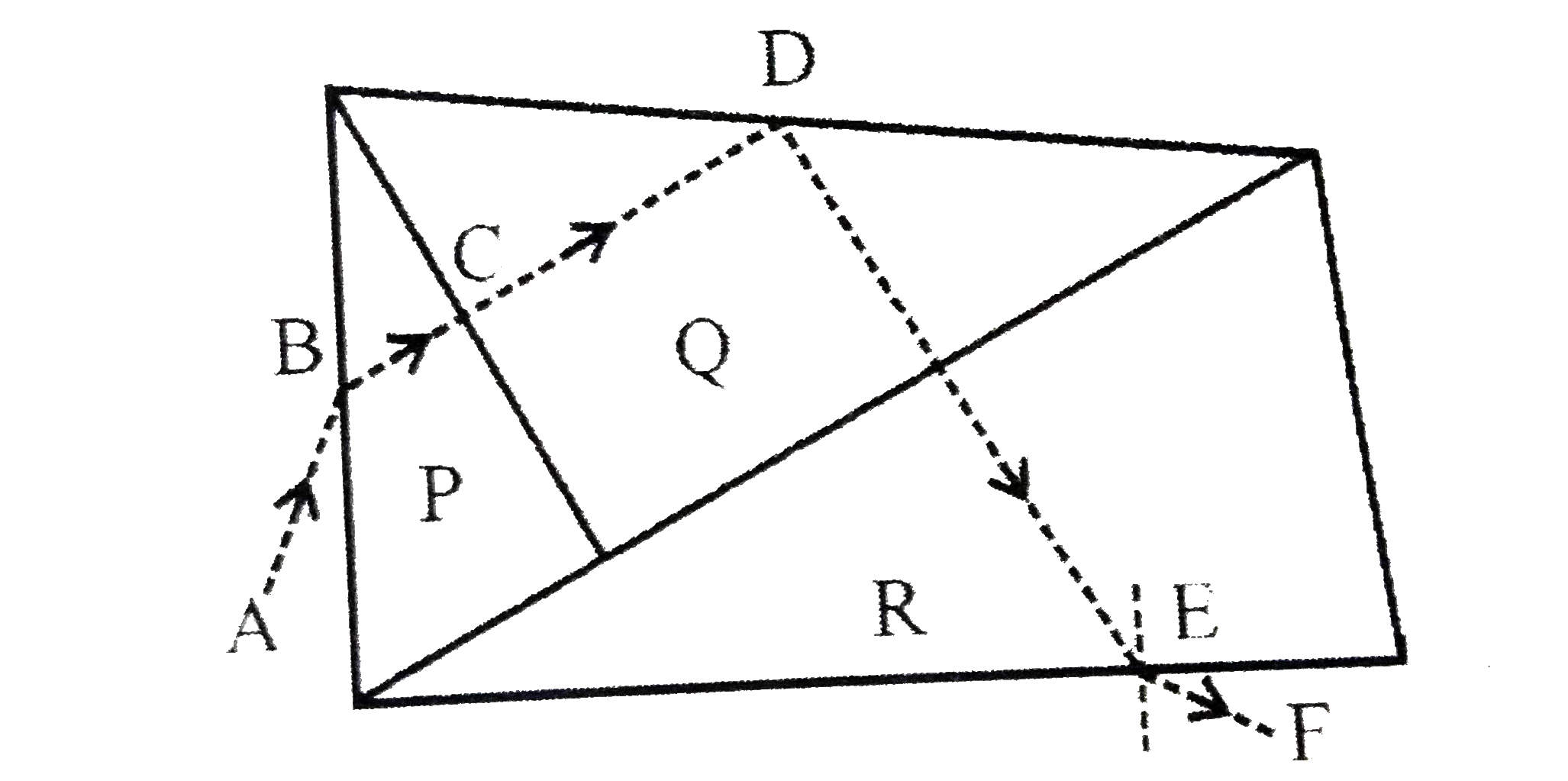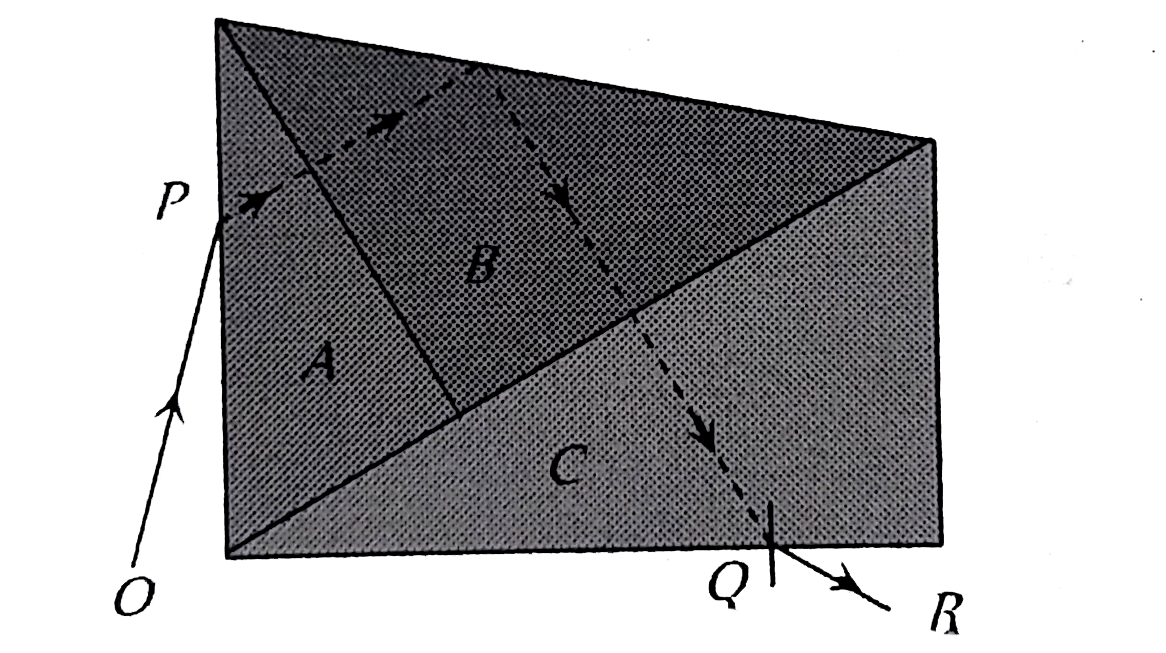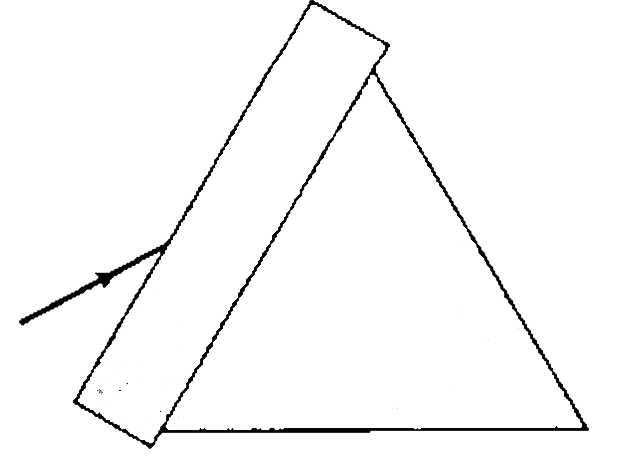Three glass prisms P , Q and R of the same refractive index are placed in contact with each other as shown in the figure with no air gap between the prisms . A monochromatic ray of light AB passes through the prism assembly and emerges as EF . In which prism , it does not suffer minimum deviation ?

in P
in Q
in R
in all the three prisms
The correct Answer is:C

When the ray suffers minimum deviation , while passing through a prism , the refracted ray is parallel to the base of the prism . This is satisfied in the prisms P and Q but this condition is not satisfied in the prism R.
[ DE is not parallel to the base of R.]
∴ It does not suffer minimum deviation in R .
Topper's Solved these Questions
- BOOK - MARVEL PUBLICATIONCHAPTER - REFRACTION OF LIGHT EXERCISE - Test Your Grasp10videos
REFRACTION OF LIGHT
- BOOK - MARVEL PUBLICATIONCHAPTER - RAY OPTICS (MIRRORS, LENSES AND OPTICAL INSTRUMENTS)EXERCISE - TEST YOUR GRASP10videos
RAY OPTICS (MIRRORS, LENSES AND OPTICAL INSTRUMENTS)
- BOOK - MARVEL PUBLICATIONCHAPTER - VECTORSEXERCISE - TEST YOUR GRASP10videos
VECTORS
Similar Questions
Three glass prisms A , B and C of same refractive index are placed in contact with each other as shown in figure, with no air gap between the prisms. Monochromatic ray of light OP passes through the prism assembly and emerges as QR . The conditions of minimum deviation is satisfied in the prisms
 View Solution
View SolutionAn equilateral prism is made up of material of refractive index √3. The angle of minimum deviation of light passing through the prism is ________.
View Solution
Knowledge Check
- Question 1 - Select One
Three glass prisms A , B and C of same refractive index are placed in contact with each other as shown in figure, with no air gap between the prisms. Monochromatic ray of light OP passes through the prism assembly and emerges as QR . The conditions of minimum deviation is satisfied in the prisms
 AA and CBB and CCA and BDIn all prisms A, B and C
AA and CBB and CCA and BDIn all prisms A, B and C - Question 2 - Select One
Three glass prism A,B and C of same refractive index are placed in contact with each other as shown in figure, with no air gap between the prisms. Monochromatic ray of light OP passes through the prism assembly and emerges as QR. The conditions of minimum deviation is satisfied in the prisms.
 AA and CBB and CCA and BDIn all prisms A,B and C
AA and CBB and CCA and BDIn all prisms A,B and C - Question 3 - Select One
A ray of light suffers refraction through an equilateral prism. The deviation produced by the prism does not depend on the:
Aangle of incidenceBcolour of lightCmaterial of prismDsize of prism
A parallel glass slab of refractive index √3 is placed in contact with an equilateral prism of refractive index √2. A ray is incident on left surface of slab as shown. The slab and prism combination is surrounded by air. The magnitude of minimum possible deviation of this ray by slab-prism combination is:
 View Solution
View SolutionA ray of light passing through a prism having refractive index √2 suffers minimum deviation. It is found that the angle of incidence is double the angle of refraction within the prism. What is the angle of prism?
View SolutionA ray of light passing through a prism having refractive index √2 suffers minimum deviation. It is found that the angle of incidence is double the angle of refraction within the prism. What is the angle of prism?
View Solution(a) If the refracting angle of a prism is 60∘ and the minimum deviation is 30∘, then find the angle of incidence.
(b) A ray of light passes through an equilateral prism such that the angle of emergence is equal to the angle of incidence and each is equal to 3/4th of the angle of prism. Find the angle of deviation.
(c) The refracting of a prism is A and the refractive index of the material of the prism is cotA/2. Find the angle of deviation.
(d) The angle of a prism is 60∘. What is the angle of incidence for minimum deviation? The refractive index of the material of the prism is √2.View SolutionThe angle of a prism is 60∘ and its refractive index is √2 . The angle of minimum deviation suffered by a ray of light in passing through it is
View Solution

